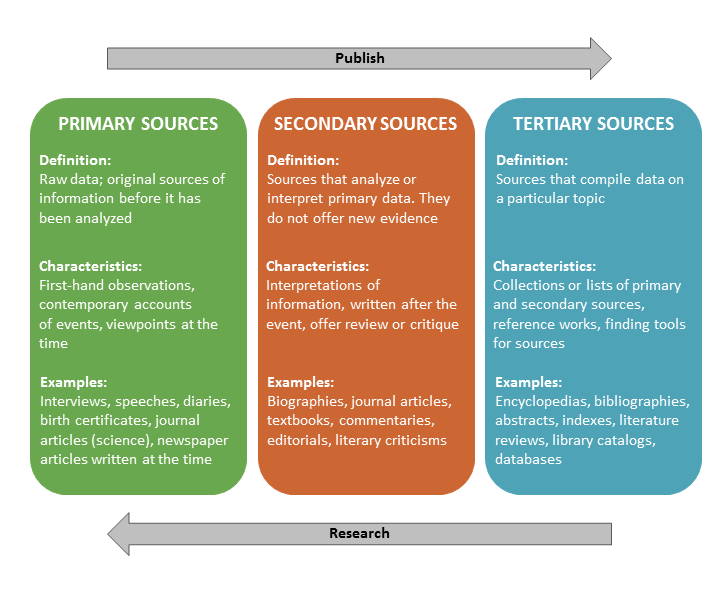How To Conduct Research
How To Evaluate Sources
Evaluate any website for currency, relevance, authority, accuracy, and purpose using this handy worksheet.
Search, select, and evaluate information sources.
Tutorials on finding and critically evaluating information sources.
Learn the differences between search engines and how to use them more effectively.
How to look at website to verify their value plus all things research-related.
Steps to Researching
Steps in the research process. Powerpoints are available for download in English and Spanish below.
Research guide from Duke University.
Primary Sources
What are Primary Sources?
"Primary sources provide first-hand testimony or direct evidence concerning a topic under investigation. They are characterized by their content, regardless of their format." (Primary Sources at Yale)
Examples:
- Artifacts (coins, plant specimens, fossils, furniture, tools, clothing)
- Audio recordings (radio programs, podcasts)
- Internet communication on e-mails and listservs
- Interviews (oral histories, telephone, e-mail)
- Journal articles in peer-reviewed publications
- Letters
- Newspapers written at the time
- Original documents (birth certificate, will, marriage license, trial transcript)
- Patents
- Photographs
- Proceedings of meetings, conferences, symposia
- Records of organizations, government agencies (annual report, treaty, constitution, govenment document)
- Speeches (including transcripts)
- Survey research (market surveys, public opinion polls)
- Video recordings (television programs)
- Works of art, architecture, literature, and music (paintings, sculptures, musical scores, buildings, novels, poems)
- Website
Finding Primary Sources:
- Calisphere: The University of California's free public gateway to a world of primary sources.
- CIESE: Science and Engineering
- Digital Library School Access: Primary sources will come up in your search results when exploring databases
- Finding Library Sources: Starting points for finding Library of Congress primary source documents
- Internet Public Library For Teens No longer updated but the resources previously linked are still available on this site.
- Library of Congress: Access the wealth of our nation's premier library
- National Archives: A trove of teacher resources and primary source documents
- Picturing America: US history through art and artifacts
- Smithsonian Education: Teachers, families, and students can find lesson plans and resources linked to Common Core State Standards and California Standards
- Smithsonian Institute: Archives materials for K-12 teachers
- Web Gallery of Art: Virtual museum and searchable database of Western European art
- World Digital Library: Browse by time period, topic, type of item, or institution
- Conversations with History: Search for interview videos by topic, time, name, transcripts also available from UC Berkeley's archives.
Teaching With Primary Sources:
- Library of Congress Teachers: Classroom materials and professional development to help teachers effectively use primary sources.
- SOAPS Primary Source Think Sheet: Tool for evaluation of primary sources using the SOAPS mnemonic: Subject, Occasion, Audience, Purpose, Speaker (see attachment below)
- Teaching with Document Lesson Plans: From the National Archives
- Teaching With Primary Sources: Using digital primary source materials from the Library of Congress
Secondary Sources
What are Secondary Sources?
"...[Secondary sources] are accounts written after the fact with the benefit of hindsight. They are interpretations and evaluations of primary sources." (University of Maryland: "Research Using Primary Sources").
Examples:
- Bibliographies
- Biographical works
- Commentaries, criticisms
- Dictionaries, encyclopedias
- Histories
- Journal articles (depending on the discipline can be primary)
- Magazine and newspaper articles (this distinction varies by discipline)
- Monographs, other than fiction and autobiography
- Textbooks
- Website (also considered primary)
Tertiary Sources
What are Tertiary Sources?
"Tertiary sources consist of information which is a distillation of collection of primary and secondary sources." (Yale University: "Comparative Sources: Primary, Secondary & Tertiary Sources").
Examples:
- Almanacs
- Bibliographies (also considered secondary)
- Chronologies
- Dictionaries and Encyclopedias (also considered secondary)
- Directories
- Fact books
- Guidebooks
- Indexes, abstracts, bibliographies used to locate primary and secondary sources
- Manuals
- Textbooks (also considered secondary)

